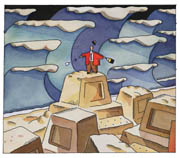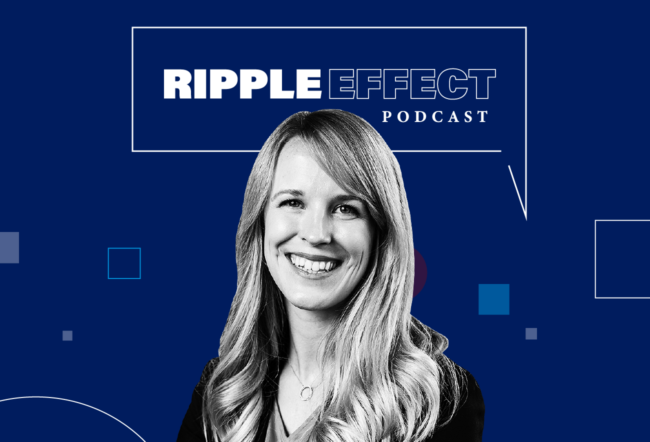Wharton professor Jean LeMaire came to Thailand last month to lead a seminar on insurance in Bangkok. Before the seminar even began, he would witness, from the uncomfortably close vantage point of a beach in Phuket, the kind of disaster that haunts insurers and humanitarian relief agencies for months to come — the devastating Asian tsunami that is estimated to have killed more than 170,000 in 11 countries.
The scale of the tragedy and the outpouring of concern from around the world have raised the tsunami to a new level of natural disaster, according to LeMaire, who teaches insurance and actuarial science. “There have been earthquakes with more deaths and more costly property damage, but this is the first truly global tragedy, with TV sets everywhere showing the same images, with people from so many countries among the casualties” and with the widespread availability of e-mail to update the news.
The 2004 Asian Tsunami Struck Many without Warning
On Dec. 26, LeMaire was making a final check of his equipment before setting out on a morning diving trip. Suddenly, the sea receded for what seemed like half a mile. LeMaire had felt an earthquake earlier that morning, but he had no idea what was coming. The German owner of the boat screamed: “Run. Run. Run away from the beach. A tidal wave is coming.”
LeMaire and three other tourists in the diving group ran 200 yards inland and watched the first wave slam into beachfront restaurants and sink the boat they were to have boarded just minutes later. LeMaire climbed on a table and snapped some pictures. That’s when he saw a second — even bigger — wave coming. He and the others then ran another half-mile inland, barely outpacing the mounting wall of water. LeMaire spent much of the rest of the day listening to radio reports in the homes of Thai hotel workers who took in the stranded tourists. Later he returned to his hotel to gather his belongings, which were undamaged in a second-floor room. He was on the first flight out of Phuket to Bangkok that afternoon.
The Fallout from the Tsunami Overwhelmed the Insurance Industry
The 2004 Asian tsunami is what insurers dread most: a low-frequency, high-consequence event that inflicts costly damage with very little way to predict where and when it will hit.
The insurance industry was not having a good year to begin with, following four hurricanes in Florida, says LeMaire. However, since the insurance market is not as well developed in the region impacted by the deadly waves, and because property values are lower, the industry will not take as great a hit as it has for other major disasters. Hurricane Andrew, for example, cost insurers $18 billion to $19 billion; the terrorist attacks on the World Trade Center could cost more than $40 billion. According to LeMaire, early estimates indicate insurers may be liable for about $10 billion as a result of the Asian tsunami. One plus for insurers, he says, is that many of the large global companies were paid premiums in dollars at a time when the currency was valued higher than it is now, when payouts are coming due.
Howard Kunreuther, co-director of the Wharton Risk Management and Decision Processes Center, says he usually argues that insurers and society can do a better job of planning for natural disasters to mitigate loss or provide adequate insurance coverage. In this case, however, he suggests that it’s not clear whether the costs of providing insurance would ever pay off given the extremely low probability of a tsunami of this magnitude occurring again.
“It’s hard to know what would be prudent or what to do. It might be prudent to do nothing. It’s really a question of the tradeoff between the costs and the benefits. That question has to be put on the table,” says Kunreuther, co-author of a new book on risk management entitled, Catastrophe Modeling: A New Approach to Managing Risk.
A Tsunami Warning System Could Have Significantly Reduced the Devastation
According to Kunreuther, a better tsunami warning system, like one used in the Pacific, might have helped the Dec. 26 event, although he is not convinced it would have made a vast difference in the many remote villages wiped out by the train of deadly waves. He notes that some people were saved because they listened to clues from the sounds of birds. “I think we are faced with an enormously challenging problem. We are looking at the misery and the loss, particularly of life, but it’s not at all clear whether the loss of lives might have been prevented.”
Overcoming Supply Chain Challenges in the Tsunami Relief Effort
Within hours after the tsunami struck, the world’s attention began to focus on relief efforts to help the survivors. Military and humanitarian operations swarmed into the region with supplies, but faced enormous problems in getting the right goods to people in isolated villages, which are difficult to reach even in the best of times.
“It’s a very challenging supply-chain problem,” says Morris Cohen, co-director of Wharton’s Fishman-Davidson Center for Service and Operations Management. “A lot of research and work has been done with the Red Cross on how to distribute emergency supplies in a disaster, but I don’t think they have ever had to face anything of this magnitude. It’s greater than anything they have anticipated.”
According to Cohen, in the case of the Asian tsunami and other disasters, it is relatively easy to gather up supplies and get them airlifted into the region’s main airport. After that, it gets tougher, as relief workers attempt to deliver goods to remote settlements on damaged roads. “There are bottlenecks and it illustrates how important it is to figure out how to get things the last mile.” The situation parallels retail distribution, he notes. “You can have all the products in the warehouses but if you can’t get them into the hands of the customer it doesn’t do any good.”
Marshall Fisher, co-director of the Fishman-Davidson Center, carries the retail analogy in another direction. In a disaster, it is difficult to know exactly what supplies are needed where. “The big problem in retailing is to figure out what people want,” says Fisher, who pointed to massive post-holiday sales as a sign of retailers’ failure to get this part of their job right. “And this is in a well-structured economy that has been doing this for decades and decades with lots of data.” He acknowledges that while consumers of disaster aid may be less fickle than a U.S. shopper debating the color of a particular sweater, the stakes are a lot higher.
“When you get down to the local retail level the exact combination of things that are available in any one community is probably hard to predict,” he says. “This is an unforeseen issue they are going to struggle with which parallels something that happens every day in retail commerce.”
Marge Tsitouris confronted all these issues as head of emergency response for CARE, the international relief organization, from 1996 to 2002. Hurricane Mitch in Central America, conflicts in Rwanda, Kosovo and Bosnia, and a famine in North Korea are just some of the disasters that occurred during her watch.
How Local Infrastructure Improvements Can Help Mitigate the Impct of Tsunami Destructiona
A long-term presence in a country is the best asset a relief organization can have when disaster strikes, she says. For example, when Hurricane Mitch struck Nicaragua, CARE was already operating education and maternal care programs locally. When the time came to get supplies down the last mile, CARE workers knew the back ways, or knew whom to hire locally to get the job done. They used local transport systems — donkeys and horses.
A local operation in the country can also help with the inventory selection problem Fisher raised. An understanding of people’s needs and of places where goods can be procured locally eliminates at least some of the requirement for transportation logistics. “We think about this before a disaster ever happens and we build in the preparedness,” says Tsitouris. “I strongly feel that sending things is not the way to go. What you want to do is build up the local capacity and, in a situation like this, purchase from local providers so you don’t have to send in planes if you don’t have to. That should be the last thing you do.”
From the start of the tsunami relief effort, CARE and other organizations, stressed that cash — not donations or materials or even volunteers on the ground — was needed most. “Everyone likes to give something,” according to Tsitouris. “After Hurricane Mitch there were people saying, ‘I have a plane. Can I fly my plane down?’ Or, ‘I can collect cans.’ People love that feeling of giving. They can say they gave the can or a frozen turkey. But that’s not necessarily the best response. There is a cost to delivering that aid and the cost is enormous.”
Well-meaning volunteers might also be just as out of place as a frozen turkey in a tropical disaster area. “It’s really important that professionals are there, someone who knows how to communicate and organize people and find the right shelter,” Tsitouris notes. “Disasters are incredibly messy. And when you see people suffering, there is a toll on you as a person. You need to have individuals there who have dealt with this before.”
In addition, local politics and culture can be a complex path to walk even in the best of times; inexperienced aid workers can make matters worse. “When you bring aid to resource-poor areas you are playing politics with who gets it and who doesn’t,” Tsitouris says. “It is extremely critical that we get it to the most vulnerable people. If you don’t understand the culture, lots of mistakes can be made.”
Military forces can be a big help in disaster relief, particularly in the first days, she adds. The military is good at setting up field hospitals for the wounded and they have access to supplies and the means to deliver goods to far-flung areas, particularly with helicopters. “They are needed for a certain period of time at the beginning. But as you get into the operation, you really must rely on government and the capacity of the people. You need the civilians to take over.”
“Probably one of the biggest logistical challenges is not sending aid to each country, but going that last mile — figuring out how to get help to the last town or place where there is no infrastructure or transportation,” says Luis Solís, professor of business operations at the Instituto de Empresa business school. “For example, whenever there were earthquakes in Central America, a large amount of aid would accumulate but there was no way to get it out [to where it was needed]. That kind of distribution can be one of the most important logistical challenges because most of the infrastructure has been destroyed or damaged.” The problem can be overcome to some extent by “relying on communications and computers to make the highest-priority aid arrive at” those specific locations where it is most needed.
Solís cites Japan as an example of a country that is well-prepared to handle disasters. “In Japan, where earthquakes and tidal waves occur more frequently, people are always busy analyzing disaster contingency plans; they know that these things can happen at any moment … In risk management, it is recognized that when you do not prepare a contingency plan, many decisions you wind up making are not necessarily the best ones. There is no time to analyze if this is or is not the right thing to do. A contingency plan tends to minimize the negative effects when events of this sort take place.”
“A cargo plane managed to make an emergency landing at the Banda Aceh airport on January 4, after running into a buffalo on the runway. The landing gear of the Boeing 737 was damaged by the collision, leading to a temporary shutdown of the airport that affected the arrival of humanitarian aid for victims of the tidal wave. Nevertheless, American military helicopters continued to operate. The airport remained closed all day. The incident forced the delay of an inter-agency mission in which the World Food Program participated. Its goal was to evaluate possible logistical channels and long-term needs along the Western coast of Aceh province. Even before the airport was shut down, its air space was approaching capacity limits because of a rising number of humanitarian flights aimed at helping more than 10,000 people in the region affected by the earthquake and tsunami of December 26.”
This press release from the United Nation’s World Food Program describes the problems confronting teams of workers sent to the area to distribute humanitarian aid. In the same document, dated January 6, the WFP requested $256 million in order to feed more than two million victims of the tsunami. “This is more than merely a disaster for the countries directly affected,” said James Morris, WFP executive director. “We are also facing disaster on a global scale. There are a lot of victims in both rich countries and poor countries … Fortunately, this tragedy has generated the fastest and most generous response in world history from donors.”
Yet generous relief aid is no substitute for sustainable development strategies in poor countries like many of those hit hardest by the tsunami. “It’s becoming clear that the bandage approach doesn’t solve the problem in the long-run,” says Blaise Judja-Sato, a Wharton graduate and founder of VillageReach, a non-profit organization offering assistance to developing countries in search of strategies to deliver needed services such as healthcare and education.
Distributing Tsunami Disaster Relief Funds
Judja-Sato is concerned about follow-up mechanisms to ensure that those who make pledges actually deliver the money. More than $4 billion has been pledged by governments. The United Nations, following allegations of corruption in its Iraqi oil-for-food program, has said PricewaterhouseCoopers will develop a financial tracking system for the U.N. on a pro bono basis.
“What happens to the population that has its expectations built up but then two or three years down the road sees that nothing happens?” Judja-Sato asks. “If life doesn’t change, what does that mean for trust in the international community?”
While regions struck by the tsunami may receive some new infrastructure, a natural disaster is not likely to become an opportunity for advancement, he notes. “You could say that because of the disaster you don’t have the weight of legacy systems. You don’t have to deal with past infrastructure.” But the time pressure involved in restoring systems to people struck by a severe calamity does not allow for good, long-term planning.
“What I think is really needed is not to wait for a disaster to happen before helping people,” says Judja-Sato. “I suspect that most of the poor folks in Sri Lanka who were affected were living in very difficult conditions with no access to basic needs … Now we realize they need water, immunizations, and education. They didn’t have all that stuff before. Why didn’t we do something about it then?”



